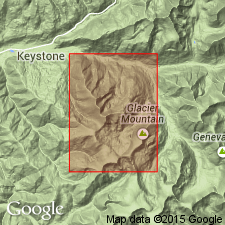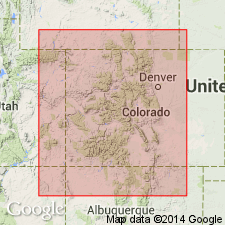
- Usage in publication:
-
- Bear Mountain granite
- Modifications:
-
- Original reference
- Dominant lithology:
-
- Granite
- AAPG geologic province:
-
- Eagle basin
Summary:
Pg. 128, map. Bear Mountain granite. Gray medium-grained biotite granite. Closely resembles Santa Fe granite, but is a biotite granite and not a biotite-muscovite granite. Occurs in more or less isolated patches and dikes. Is in contact with hornblende-gneiss series (pre-Cambrian). Age is considered pre-Cambrian(?).
Forms summit of Bear Mountain, Summit Co., central northern CO.
Source: US geologic names lexicon (USGS Bull. 896, p. 133).

- Usage in publication:
-
- Bear Mountain Granite†
- Modifications:
-
- Abandoned
- AAPG geologic province:
-
- Southern Rocky Mountain region
Summary:
Pg. D7. †Bear Mountain Granite. Obsolete name. Small pods later assigned to Silver Plume Granite.
(See Lovering, 1935, USGS Prof. Paper 178; Lovering and Goddard, 1950, USGS Prof. Paper 223.)
Source: Publication.
For more information, please contact Nancy Stamm, Geologic Names Committee Secretary.
Asterisk (*) indicates published by U.S. Geological Survey authors.
"No current usage" (†) implies that a name has been abandoned or has fallen into disuse. Former usage and, if known, replacement name given in parentheses ( ).
Slash (/) indicates name conflicts with nomenclatural guidelines (CSN, 1933; ACSN, 1961, 1970; NACSN, 1983, 2005, 2021). May be explained within brackets ([ ]).

